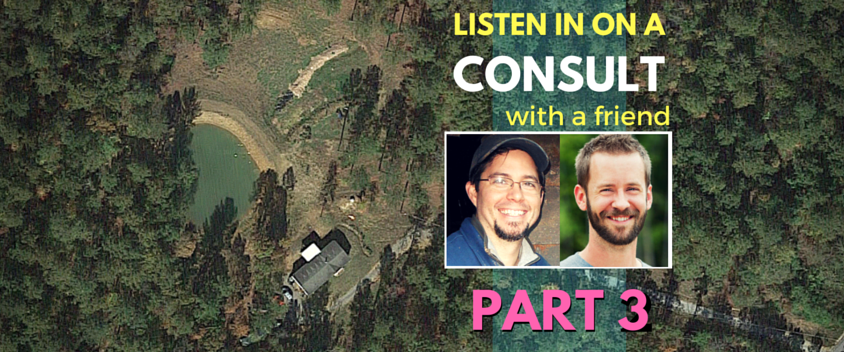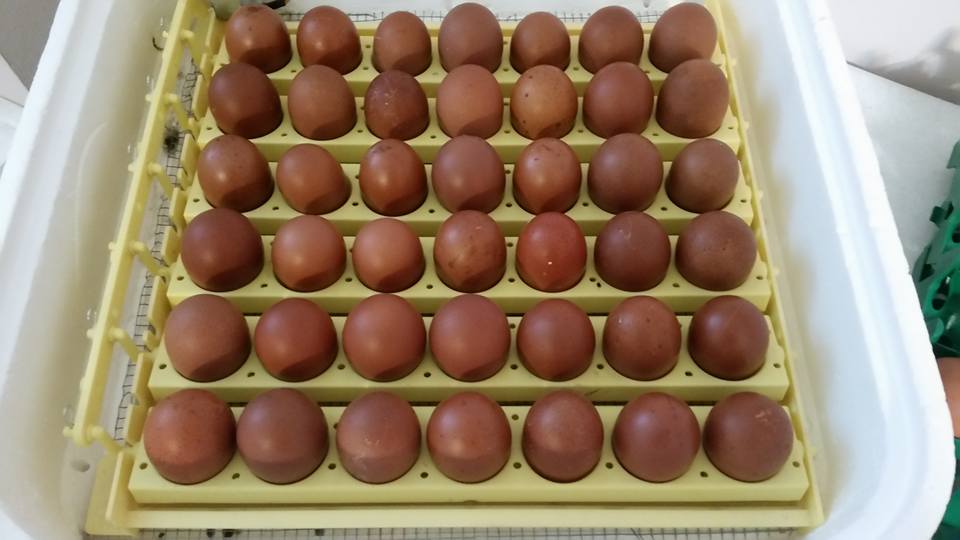E0030 | Listen in on a Consult with a Friend: Part 3
Podcast: Play in new window | Download
Subscribe: iTunes | Android | RSS
Welcome back to another episode of the Homegrown Liberty Podcast. This is episode 30! Thank you for tuning in, this week Ken and I are finishing our conversation from the past two weeks. I wanted to make sure you get this bit of news straight away. I’m going to be heading up to St Louis September 4th for the Garlic Fest, and if you want to schedule for me to swing by your place either before, or after the 4th through the 6th, I already have people scheduling to have me come to their properties! If you’ve been wanting me to come to your property and help you with the design, or troubleshoot issues you’ve been having on your homestead, now is the time! Your cost will be drastically reduced because I’ll be on the road already! So if you live in North Louisiana, Arkansas, Missouri, Southern Illinois, Western Kentucky, Tennessee, or Mississippi, send me an email and get on the roster because these consulting tours get full very quickly. I’ll be scheduling consults for both my trip up there, and my trip home. Check your calendar and email me, It’ll be first come first served!
Before we get into the conversation, I wanted to just go over what we talked about briefly. We talk about some embarrassing mistakes, an inside joke, solarizing garden beds, some great tips for killing weed seeds in your garden beds, and killing grass in those beds.
We talk about some unusual garden season extension techniques and the fact that my gardening season is different than most people especially around here think it is. Ken shares some of his final takeaways from the past year of gardening, and shares some of his successes and failures with saving the product of the garden. And I share a couple really cool tips and tricks to making your gardening job easier, less work, and cheaper for the next year. Lots of laughter, lots of fun.. We had a lot of fun in this last section of the conversation.
So let’s start the show! What’s that last thing you had for us Ken?
[INTERVIEW WITH NICK & KEN]
Alright, well I’m gonna take over here real quick and finish this episode off with some of my thoughts on solarizing garden beds, and a little bit of my plans for the next month.
On tarping your beds, really give this a chance. I know plastic isn’t the best thing to use, and I certainly don’t think it’s a long term solution to gardening needs. It is however a fantastic means to set yourself up for success in the short term with drastically reduced weed pressures, and much healthier soils. If you’re having issues with soil borne diseases, try solarizing those beds. If you’re fighting with weeds taking over and you haven’t been mulching, solarize first, then add mulch, if you have mulch already on the beds, scrape it all off, use it for the compost pile. Solarize the bed, then put down fresh mulch. Here’s the deal with this technique. Let’s say you put a black tarp up and sit underneath it on a hot sunny day. Are you going to be cooler or hotter? It’s shade! You’re going to be cooler! What if it’s clear plastic, if that’s the case, it probably won’t do anything different than being in the full sun. Now let’s take it another step. Let’s say you have some hoops and they allow you to put that black plastic completely above and around you all the way to the ground. It’ll probably feel hotter due to lack of airflow and increased humidity, but it’s not likely to get a whole lot hotter underneath. But if that plastic is clear, well, you just made a greenhouse and it’ll keep getting hotter, and hotter underneath. It’ll get hot enough to actually pasteurize. That’s what you do to the soil when you solarize. “But pasteurizing your soil is a bad thing” some of you might think. Well is it? Is a compost pile devoid of bacterial and fungal life? Or is it absolutely full of it?! Compost piles get as hot as 160F-170F. That’s about how hot it gets the top 6” or so of soil under that clear plastic, and if you aren’t tilling your garden beds (and you shouldn’t) then the weed seeds get cooked, and you’re left with nice, healthy soil, and a lot of dead seeds for worms to move back in and eat.
Another thing I almost forgot, Josh and Angie asked about beneficial insects under the row covers. And pollination with bees. Ok, well most plants don’t actually require pollination to produce what you’re going to eat, but things that do require pollination will need to be uncovered when it’s time to produce, or you’ll have to go out in the evening or early morning and pollinate by hand. If you get a makeup brush or a round puffy paint brush, something real soft, you can pollinate squash by hand relatively easily, same goes for melons, but those are a little unruly for row covers anyways. Other than pollination, you can actually introduce beneficial insects under your row covers if you need them. Things like ladybugs will be fine introduced, and I’ve even heard of people putting a beehive in a screened tent attached to the row covers, the bees hum along and pollinate for a couple days, then the row covers are closed back off and the tent opened back up for the bees to go do their thing elsewhere. I think that’s taking it a little too far, but generally if you need pollination, just keeping the plant covered until it’s large enough to fruit will put you far and above past the alternative that it’s worth it. Just remember to remove the covers, clean them, and carefully wrap them up for next season.
Man, we’ve gotten a lot of great, positive feedback on this show style! And a lot of people sent me messages and left comments about how these shows have encouraged you guys, and helped you to not feel so left out, or incapable. And I just want to really touch on this a bit.. It doesn’t matter how advanced you are, it doesn’t matter if you’ve met with failure after failure and you feel like you can’t get it right and that you’ll never make it. What matters is that you have met failure. You see, if you’ve never failed, then that means you’ve never tried. And if you’ve never tried, then that’s just sad. It’s the people who stand up, decide to work, to put in the effort to make something happen, those are the people you see with success. And I guarantee that every single one of them has met with failure, and probably failed more times than they’ve been successful. I’ll be the first to admit, I do not have all the answers, I don’t always get it right. But when I fall down, I get right back up, wipe the grit out of my wounds, and I try again. I’ve had gardens obliterated by insects, disease, drought, rain, frost, animals, and my own dumb negligence. But I keep at it. Some years are better than others, and to be honest, this spring has not been one of those good years. But I’m excited to get the opportunity to use my two hands, and two feet to try again this fall, because thank God I still have all those parts of me that enable me to keep working towards my goals. So as long as I have breath in me, I’ll keep at it. I learn how to do things better every year, I learn something new every week. So as superman said, “Don’t give up, don’t lose hope, don’t sell out”. Keep on walking this journey with me, with all of us in the Homegrown Liberty community. Don’t think you’re the only one out there who’s having a problem on your homestead. Be real, reach out to us and let us help you figure things out. That’s what we’re all here for! I mean, for goodness sake, I put the word out that I was looking for some hens that were getting ready to start laying and someone who listens to the show offered to give me 2 dozen birds! And not any chicken, a rare breed that I’ve never been able to afford! I’m getting 2 dozen Black Copper Marans that lay the darkest, most beautiful eggs you’ll ever see! So Staci, I can’t thank you enough for your generosity. I really appreciate it!
And I want to remind you one more time, I’m going to be heading to St Louis Missouri the first week of september, so if you want to get in on some reduced cost consulting, email me, but don’t be slow about it, because I never can get everyone worked in on the schedule who emails me on these consulting tours. We can do just a couple hours, or a full day, whatever you need, we can figure it out.
To submit a question for the show or to contact me, just send an email to nick@homegrownliberty.com
Until next week
I hope you have a wonderful day, God Bless. And as always “Go Do Good Things”




“…it doesn’t matter if you’ve met with failure after failure and you feel like you can’t get it right and that you’ll never make it. What matters is that you have met failure. You see, if you’ve never failed, then that means you’ve never tried. And if you’ve never tried, then that’s just sad. It’s the people who stand up, decide to work, to put in the effort to make something happen, those are the people you see with success.”
Nick, those words brought tears to my eyes and were just what I needed to hear today! I have felt about as low and defeated lately as I ever have! I was thinking about my journey into homesteading and realized that I’ve been at this now for 5 years and the failures have been far greater than the successes. But, as tempting as it is to just quit, it just isn’t in me. My ancestors were pioneers and I guess I inherited their determined spirits. Hopefully, eventually, I’ll unearth that gardening gene, too!
Nick,
I think the “Listen in on consult” podcasts are great. You have a gift of explaining theory and then urging folks to apply it. This format closes that loop to show that theory and application feed off of each other. Please do a follow with Ken in six months or so to show the progress from the discussion in this consult.
I truly appreciate all the good things you do and share with your listeners.
Every thought about building a coldframe like device that is portable to solarize raised beds or areas already covered in undesirable vegetation.
Have a great week,
JR
Well the issue with a device like a coldframe is that you want that plastic as close to the soil surface as possible to keep as much heat trapped as you can. It’s meant to heat the soil, not necessarily the air. So the best thing is to just mow the area and cover with clear plastic. Simple and easy.
You mentioned how you clean up and store your row covers at the end of the season. It would be great if you could walk us through your end of the season cleanup when that time comes ?